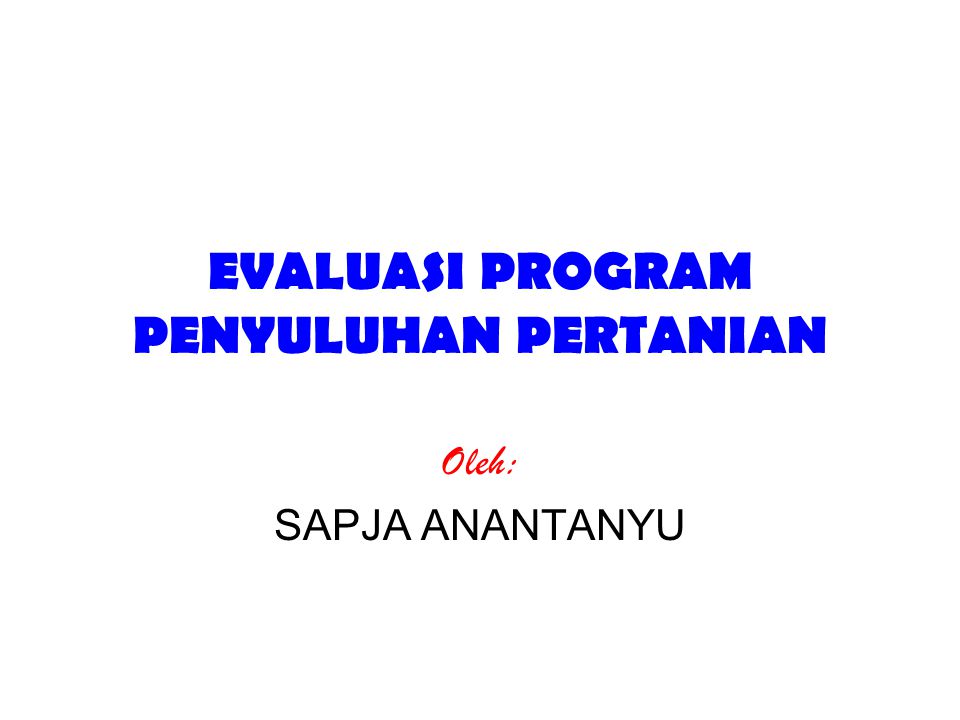Contoh Program Penyuluhan Pertanian Ppta

Jan 29, 2019 - Please, help me to find this contoh folder penyuluhan pertanian pdf. I found one site (database) with millions of pdf ebooks, programs, music,. Badan Penyuluhan dan Pengembangan SDM Pertanian, Tahun 201 4 • -Penerapan hasil program e-sipp sampai dengan tahun 2014. Yang disampaikan pada: workshop program e-sipp upt pelatihan pertanian.
PENERAPAN HASIL PROGRAM E-SIPP SAMPAI DENGAN TAHUN 2014 Di BBPP BATANGKALUKU, SULAWESI SELATAN TANGGAL 19 – 22 MARET 2014 Yang disampaikan pada: WORKSHOP PROGRAM E-SIPP UPT PELATIHAN PERTANIAN PUSAT Badan Penyuluhan dan Pengembangan SDM Pertanian, Tahun 2014 • Elektronik Sistim Informasi Pelatihan Pertanian (e-SIPP). PUSAT PELATIHAN PERTANIAN PUSLATAN Berdasarkan Peraturan Menteri Pertanian Nomor: 16/Permentan/OT.140/J/02/12 tentang Pelaksanaan Monitoring dan Evaluasi Pendidikan dan Pelatihan Pertanian Tahun 2012, Pusat Pelatihan Pertanian, bersama UPT Pelatihan dalam mendukung PENINGKATAN KUALITAS PENGELOLAAN DATA BPPSDMP telah merancang suatu sistem aplikasi yaitu: Elektronik Sistim Informasi Pelatihan Pertanian (e-SIPP). KEMENTAN SmartArt custom animation effects: vertical box list (Intermediate) To reproduce the SmartArt effects on this slide, do the following: Press and hold CTRL, and then select the third pair of rectangles from the top (both the smaller, first-level rectangle and the larger, second-level rectangle). Under SmartArt Tools, on the Design tab, in the Create Graphic group, click the arrow next to Add Shape, and then click Add Shape After. On the Insert tab, in the Illustrations group, click SmartArt. In the Choose a SmartArt Graphic dialog box, in the left pane, click List.
In the List pane, click Vertical Box List (first row, fourth option from the left), and then click OK to insert the graphic into the slide. On the Home tab, in the Slides group, click Layout, and then click Blank. Select the graphic, and then click one of the arrows on the left border. In the Type your text here dialog box, enter text.
(Note: To create a bullet below each heading, select the heading text box in the Type your text here dialog box, and then under SmartArt Tools, on the Design tab, in the Create Graphic group, click Add Bullet.  Enter text into the new bullet text box.) Select the graphic.
Enter text into the new bullet text box.) Select the graphic.
Under SmartArt Tools, on the Format tab, click Size, and then do the following: In the Width box, enter 6.67”. In the Height box, enter 5.92”. Under SmartArt Tools, on the Format tab, click Arrange, click Align, and then do the following: Click Align to Slide. On the Design tab, in the Themes group, click Colors, and then under Built-in click Civic. (Note: if this action is taken in a PowerPoint presentation containing more than one slide, the color scheme will be applied to all of the slides.) Click Align Center.
Click Align Middle. Under SmartArt Tools, on the Design tab, in the SmartArt Styles group, do the following: Click More, and then under 3-D click Polished (first row, first option from the left). Click Change Colors, and then under Accent 1 click Colored Fill – Accent 1 (second option from the left). Press and hold CTRL, and then select the four larger, second-level rectangles. Under SmartArt Tools, on the Format tab, in the Shapes group, click Change Shape, and then under Rectangles click Rounded Rectangle (second option from the left). Under SmartArt Tools, on the Format tab, in the Shape Styles group, click the arrow next to Shape Fill, point to Gradient, and then click More Gradients. In the Format Shape dialog box, in the left pane, click Fill, select Gradient fill in the Fill pane, and then do the following: On the Home tab, in the Font group, select Franklin Gothic Book from the Font list, and then select 24 from the Font Size list.
Click the button next to Direction, and then click Linear Up (second row, second option from the left). In the Type list, select Linear. Also under Gradient stops, customize the gradient stops as follows: Under Gradient stops, click Add or Remove until two stops appear in the drop-down list. Select Stop 1 from the list, and then do the following: In the Stop position box, enter 0%.
Select Stop 2 from the list, and then do the following: Click the button next to Color, and then under Theme Colors click White, Background 1, Darker 35% (fifth row, first option from the left). Click the button next to Color, and then click Black, Text 1, Lighter 25% (fourth row, second option from the left). In the Stop position box, enter 100%.
Also in the Format Shape dialog box, in the left pane, click 3-D Format, and then do the following in the 3-D Format pane: Under Depth, in the Depth box, enter 1 pt. Under Bevel, click the button next to Top, and then under Bevel click Circle (first row, first option from the left). Next to Top, in the Width box, enter 4 pt, and in the Height box, enter 4 pt. Select the top first-level rectangle. Under SmartArt Tools, on the Format tab, in the Shape Styles group, click the arrow next to Shape Fill, point to Gradient, and then click More Gradients. In the Format Shape dialog box, in the left pane, click Fill, select Gradient fill in the Fill pane, and then do the following: On the slide, press and hold CTRL, and then select the four smaller, first-level rectangles.